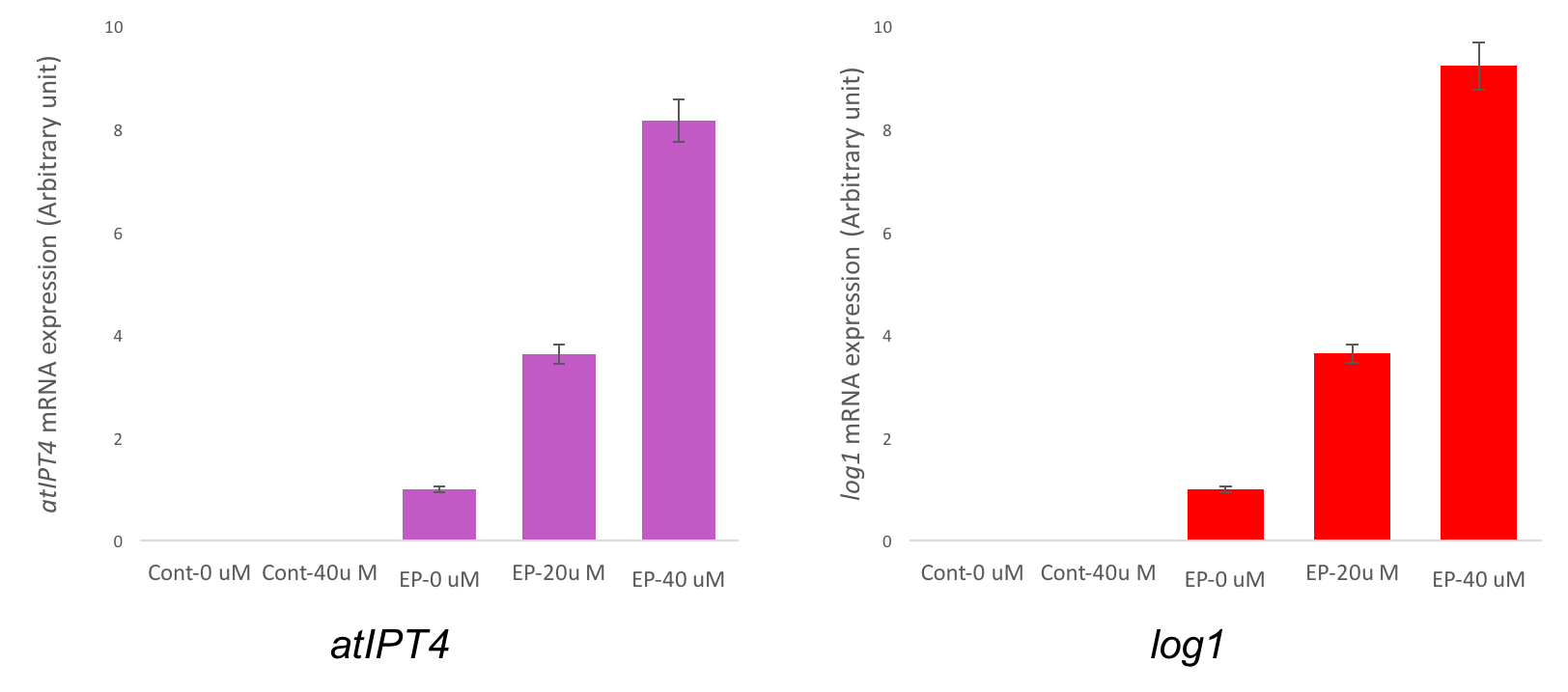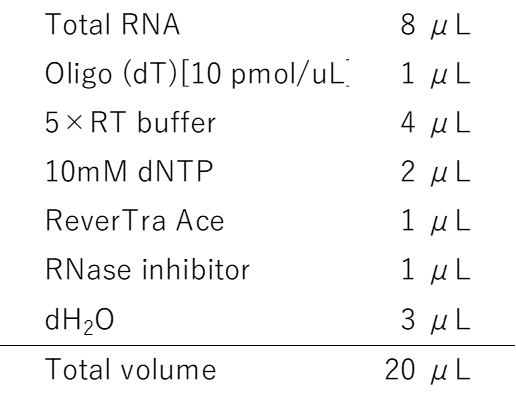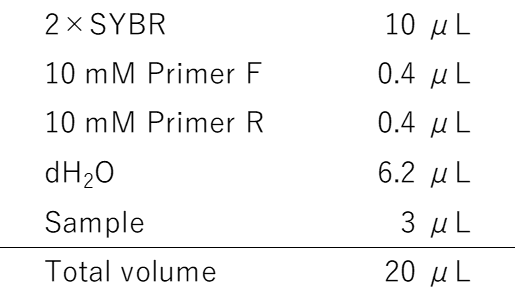Difference between revisions of "Part:BBa K2505002"
| Line 111: | Line 111: | ||
Kurakawa, T., Ueda, N., Maekawa, M., Kobayashi, K., Kojima, M., Nagato, Y., ... Kyozuka, J. (2007). Direct control of shoot meristem activity by a cytokinin-activating enzyme. Nature, 445(7128), 652-655. | Kurakawa, T., Ueda, N., Maekawa, M., Kobayashi, K., Kojima, M., Nagato, Y., ... Kyozuka, J. (2007). Direct control of shoot meristem activity by a cytokinin-activating enzyme. Nature, 445(7128), 652-655. | ||
| − | |||
| − | |||
Latest revision as of 18:21, 1 November 2017
atipt4
Sequence and Features
- 10COMPATIBLE WITH RFC[10]
- 12COMPATIBLE WITH RFC[12]
- 21COMPATIBLE WITH RFC[21]
- 23COMPATIBLE WITH RFC[23]
- 25INCOMPATIBLE WITH RFC[25]Illegal NgoMIV site found at 739
- 1000INCOMPATIBLE WITH RFC[1000]Illegal BsaI site found at 881
This gene is derived from Arabidopsis thaliana and encodes a enzyme necessary for synthesizing precursor of isopentenyladenine (iP), a kind of cytokinin. Cytokinins are signaling molecules (Phytohormones) in plants and play important roles in cell growth and differentiation. AtIPT4 has the adenylate dimethylallyltransferase ([http://www.genome.jp/dbget-bin/www_bget?ec:2.5.1.112 [EC:2.5.1.112] ]: cytokinin synthase) activity and catalyzes the transfer of an isopentenyl group from dimethylallyl diphosphate (DMAPP) to ATP and ADP, producing cytokinin nucleotides. Note that cytokinin nucleotides are the immature form.
The DNA sequences of atipt4 optimized for expressing in human cells considering the codon usage.
Contents
Characterization
In this assay, we investigated whether human cells (the EA.hy926 cell line) receive AHL, a signaling molecule that is synthesized in and exported from E. coli and induce the transcription of atIPT4 and log1 genes to synthesize iP.
AHLs, which stand for [N-]acyl-homoserine lactones, are small signaling molecules and are employed in the bacterial “Quorum Sensing”. Among several kinds of AHLs, 3OC8HSL (C8) was chosen in the assay.
In order to achieve C8-dependent transcription in human cells, a chimeric transcription factor named RelA/NLS/traR was constructed. This protein is comprised of the transcription activating domain of RelA (a kind of human NF-kB family), nuclear localization signal (NLS), and full-length traR. This protein can bind to an appropriate enhancer sequence to activate transcription only in the presence of C8 (see below for details).
Isopentenyladenine (iP) is kind of a cytokinin, and we use it as a signal molecule from human to E. coli cells and for the inter-kingdom communication. Cytokinins are the signaling molecules (or Phytohormones) that plants produce and play important roles in cell growth and differentiation. In the case of Arabidopsis thaliana, extracellular iP is received by a transmembrane receptor, AHK4.
AHK4 has a histidine kinase activity, and binding of iP to AHK4 triggers auto-phosphorylation of AHK4 and the following histidine-to-aspartate phosphorelay. As a consequence, transcription from target genes is induced and/or repressed so that physiological states of plants are changed. Surprisingly, the histidine kinase activity of AHK4 has shown to be activated depending on iP even in E. coli cells (Suzuki et al. 2001, Lukáš Spíchal et al. 2004). This fact encouraged us to use iP as a signaling molecule in our project (See the AHK4 assay page).
Result
The transformed cells were treated or not treated with different concentrations of C8. Then, the mRNA level of atIPT4 and log1 was analyzed using quantitative RT-PCR. As shown in Figure 1, the CMV minimal promoter was activated following the addition of C8.
Discussion
We confirmed that the transcription of atIPT4 and log1) genes were induced by C8 addition and the degree of induction depends on C8 concentration.
Material and Method
Plasmids
- Sample
pCAG-relA/NLS/traR-polyA (pMC1neo-polyA)
(trabox)7-CMVmin-atIPT4-IVS-IRES-log1-polyA(pIRESneo3)
Construction
- Cell line
All the plasmids were prepared in Homo sapiens EA.hy926 cell line.
Medium
- DMEM 10% FBS
- DMEM 10% FBS G418 (400 μg/mL)
The primers for quantitative RT-PCR
- atIPT4
Forward: 5’- gtgcaacgacaaaatggtgg-3’ Reverse: 3’-cctgaagatcacgaccaatcg-5’
- log1
Forward: 5’-ggactgatctctcaggctgtg-3’ Reverse: 3’-cggtagcagatatgcatcagc-5’
Protocol
1. The EA.hy 926 cells were cultured to about 1.0 * 107 cells/dish (the dish size is 10 cm in diameter) and used for electroporation.
2. C8 was added to the dish at final concentration of 0, 20, or 40 μM and incubated further for 24 hours.
3. After harvesting the cells, total RNAs were purified according to the ordinary AGPC (Acid guanidinium thiocyanate-phenol-chloroform) method, and cDNAs were obtained by reverse transcription(Table. 1).
4. qPCR was performed using the above cDNA(Table. 2).
AGPC methods
①Vortex the collected cells in the tube for 10 to 15 sec.
②Add 1/10 volume of Na acetate.
③Add 1.4-times volume of Phenol/Chloroform/Isoamyl alcohol.
④Vortex every 10 minutes.
⑤Centrifuge at 15000 rpm, 10 min, 4 ° C.
⑥Recover the aqueous layer and mix with 400 uL isopropanol.
⑦Leave at -20 ° C for 1 hour.
⑧Centrifuge at 15000 rpm, 10 min, 4 ° C and remove supernatant.
⑨Add 400 uL of 75% ethanol, centrifuge at 15000 rpm, 10 min, 4 ° C and remove supernatant.
⑩Dry the pellet and dissolve with 10 uL of pH = 7.4 TE buffer
Reference
Kakimoto, T.(2001). Identification of plant cytokinin biosynthetic enzymes as dimethylallyl diphosphate:ATP/ADP isopentenyltransferases. Plant Cell Physiol, 42:677-85.
Kurakawa, T., Ueda, N., Maekawa, M., Kobayashi, K., Kojima, M., Nagato, Y., ... Kyozuka, J. (2007). Direct control of shoot meristem activity by a cytokinin-activating enzyme. Nature, 445(7128), 652-655.



